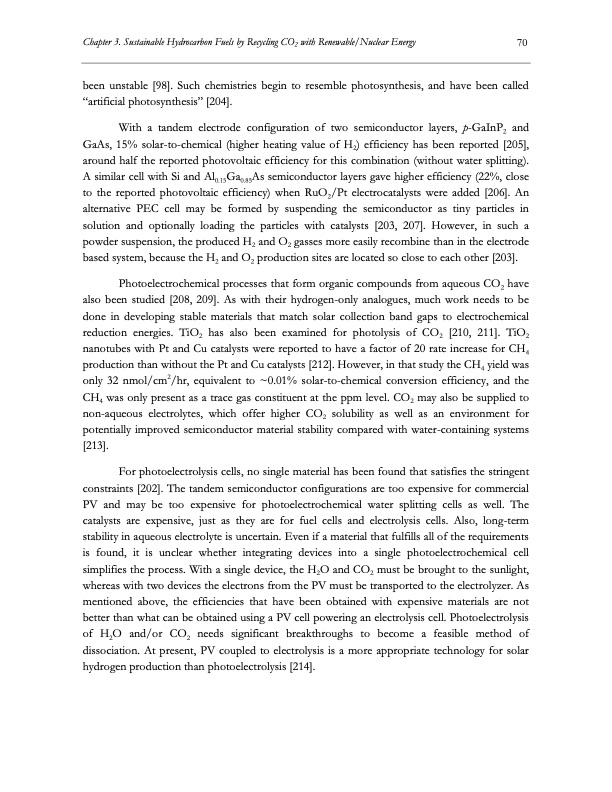
PDF Publication Title:
Text from PDF Page: 091
Chapter 3. Sustainable Hydrocarbon Fuels by Recycling CO2 with Renewable/Nuclear Energy 70 been unstable [98]. Such chemistries begin to resemble photosynthesis, and have been called ―artificial photosynthesis‖ [204]. With a tandem electrode configuration of two semiconductor layers, p-GaInP2 and GaAs, 15% solar-to-chemical (higher heating value of H2) efficiency has been reported [205], around half the reported photovoltaic efficiency for this combination (without water splitting). A similar cell with Si and Al0.15Ga0.85As semiconductor layers gave higher efficiency (22%, close to the reported photovoltaic efficiency) when RuO2/Pt electrocatalysts were added [206]. An alternative PEC cell may be formed by suspending the semiconductor as tiny particles in solution and optionally loading the particles with catalysts [203, 207]. However, in such a powder suspension, the produced H2 and O2 gasses more easily recombine than in the electrode based system, because the H2 and O2 production sites are located so close to each other [203]. Photoelectrochemical processes that form organic compounds from aqueous CO2 have also been studied [208, 209]. As with their hydrogen-only analogues, much work needs to be done in developing stable materials that match solar collection band gaps to electrochemical reduction energies. TiO2 has also been examined for photolysis of CO2 [210, 211]. TiO2 nanotubes with Pt and Cu catalysts were reported to have a factor of 20 rate increase for CH4 production than without the Pt and Cu catalysts [212]. However, in that study the CH4 yield was only 32 nmol/cm2/hr, equivalent to ~0.01% solar-to-chemical conversion efficiency, and the CH4 was only present as a trace gas constituent at the ppm level. CO2 may also be supplied to non-aqueous electrolytes, which offer higher CO2 solubility as well as an environment for potentially improved semiconductor material stability compared with water-containing systems [213]. For photoelectrolysis cells, no single material has been found that satisfies the stringent constraints [202]. The tandem semiconductor configurations are too expensive for commercial PV and may be too expensive for photoelectrochemical water splitting cells as well. The catalysts are expensive, just as they are for fuel cells and electrolysis cells. Also, long-term stability in aqueous electrolyte is uncertain. Even if a material that fulfills all of the requirements is found, it is unclear whether integrating devices into a single photoelectrochemical cell simplifies the process. With a single device, the H2O and CO2 must be brought to the sunlight, whereas with two devices the electrons from the PV must be transported to the electrolyzer. As mentioned above, the efficiencies that have been obtained with expensive materials are not better than what can be obtained using a PV cell powering an electrolysis cell. Photoelectrolysis of H2O and/or CO2 needs significant breakthroughs to become a feasible method of dissociation. At present, PV coupled to electrolysis is a more appropriate technology for solar hydrogen production than photoelectrolysis [214].PDF Image | Electrolysis of CO2 and H2O

PDF Search Title:
Electrolysis of CO2 and H2OOriginal File Name Searched:
co2-hso-fuels.pdfDIY PDF Search: Google It | Yahoo | Bing
NFT (Non Fungible Token): Buy our tech, design, development or system NFT and become part of our tech NFT network... More Info
IT XR Project Redstone NFT Available for Sale: NFT for high tech turbine design with one part 3D printed counter-rotating energy turbine. Be part of the future with this NFT. Can be bought and sold but only one design NFT exists. Royalties go to the developer (Infinity) to keep enhancing design and applications... More Info
Infinity Turbine IT XR Project Redstone Design: NFT for sale... NFT for high tech turbine design with one part 3D printed counter-rotating energy turbine. Includes all rights to this turbine design, including license for Fluid Handling Block I and II for the turbine assembly and housing. The NFT includes the blueprints (cad/cam), revenue streams, and all future development of the IT XR Project Redstone... More Info
Infinity Turbine ROT Radial Outflow Turbine 24 Design and Worldwide Rights: NFT for sale... NFT for the ROT 24 energy turbine. Be part of the future with this NFT. This design can be bought and sold but only one design NFT exists. You may manufacture the unit, or get the revenues from its sale from Infinity Turbine. Royalties go to the developer (Infinity) to keep enhancing design and applications... More Info
Infinity Supercritical CO2 10 Liter Extractor Design and Worldwide Rights: The Infinity Supercritical 10L CO2 extractor is for botanical oil extraction, which is rich in terpenes and can produce shelf ready full spectrum oil. With over 5 years of development, this industry leader mature extractor machine has been sold since 2015 and is part of many profitable businesses. The process can also be used for electrowinning, e-waste recycling, and lithium battery recycling, gold mining electronic wastes, precious metals. CO2 can also be used in a reverse fuel cell with nafion to make a gas-to-liquids fuel, such as methanol, ethanol and butanol or ethylene. Supercritical CO2 has also been used for treating nafion to make it more effective catalyst. This NFT is for the purchase of worldwide rights which includes the design. More Info
NFT (Non Fungible Token): Buy our tech, design, development or system NFT and become part of our tech NFT network... More Info
Infinity Turbine Products: Special for this month, any plans are $10,000 for complete Cad/Cam blueprints. License is for one build. Try before you buy a production license. May pay by Bitcoin or other Crypto. Products Page... More Info
| CONTACT TEL: 608-238-6001 Email: greg@infinityturbine.com | RSS | AMP |